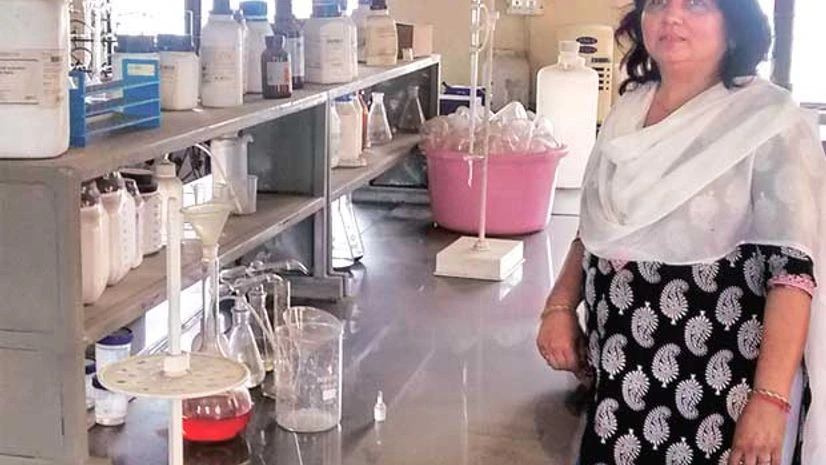For Ravinder Singh, the red and white building, just a few metres away from their 10-bigha farm is nothing more than a regular government office, where officials come and go without having any impact on their lives.
Though they are aware the building has something to do with agriculture, the Singhs have for years not received any help from the scientists and researchers at Krishi Vigyan Kendra (KVK), except initially, when it had shifted to their village.
"Meetings and seminars are held there; a few selected farmers come to have lunch and refreshment," says Singh, 30, pointing towards the building. It is well into June, and he is not even aware that there is the possibility of a drought in north India. He says nobody from the office has come to him to tell what to do if crops fail.
More From This Section
The kendras are supposed to be the last-mile outreach between the Centre and India's millions of farmers, before a network of state officials take over. Conceptualised in 2004 to impart both on- and off-field training to growers, and to bring information on the latest technologies from labs to farms, the kendras today are failing, at least in this part of the country. In total, there are over 600 kendras, one in each district.
Almost 12 kendras in western Uttar Pradesh are under the administrative jurisdiction of the Sardar Vallabhbhai Patel University of Agriculture and Technology, Meerut, a state agriculture university.
Inside the Ghaziabad kendra, near the Singhs' home, an abandoned jeep, a marshland in place of a nursery, a lone computer, a library filled with moth-eaten old manuals and a closed laboratory, are immediately visible.
Huddled in one of the empty rooms are six assistant professors and a lab technician, discussing the heat wave and the toll it is taking on their daily commute from neighbouring Meerut.
Typically, a kendra is mandated to have 16 staffers, a majority of whom have to be from one of the agriculture streams of livestock and plant protection. P S Tiwari, an assistant professor, describes the work the kendra has been doing in education and imparting training on new farm technologies.
A little prodding, though, brings out the real story. Since April, Tiwari says, funds have not been allocated and many of them have not received their salaries on time.
"Till last year, we were given Rs 1,50,000 a year for maintaining one jeep, two motorcycles and a tractor. But this year it has been slashed to Rs 80,000. Of this, the expenditure on insurance alone is around Rs 16,000. How does the government expect us to conduct trainings and go to fields if we are not able to maintain such basic requirements," Tiwari laments. The Muradnagar centre covers the Ghaziabad district and the neighbouring Hapur district. "Even if we plan to visit one village in a day, it will take us over a year to cover these districts," he says. Therefore, the scientists have decided to reduce their field visits. "We are left with no choice but to visit the nearby villages and limit our engagement with farmers," he says.
In the soil testing and research lab, behind the main building, rows of unused beakers, empty bottles and refrigeration equipment are proof of how public funds are squandered because of poor planning and all-too-familiar infrastructure problems.
"You seldom get constant power. Now if we get electricity from midnight to 8 am, how will we do research," Tiwari asks. Lab assistant brandishes the personal laptop he brings for sending mails, as the official one has been out of order for years. "Even if the Centre releases funds by June-end, we won't have enough time for field demonstrations as farmers by that time will have made their sowing decision," he says.
A working group report on the 12th Five-Year Plan (2012-13 to 2016-17) said the kendras were overburdened, and there was an urgent need to improve the staff strength, infrastructural facilities and working budget, to make them more viable. On Wednesday, the cabinet approved an outlay of an additional Rs 3,900 crore to strengthen kendras and establish 109 new ones.
For their part, the Ghaziabad staff have made several representations to the state agricultural university to review their work structure, but have been snubbed with the curt reply that it is the Centre's responsibility to allocate funds, and not the university's.
"We are neither here nor there; the university says we are not under its control as our salaries and funds come from the Centre, while the government feels we are the university's responsibility," Tiwari says, pointing out he has got no promotion in 10 years and draws the same pay as a decade ago.
Ninety kilometres down the highway, another kendra in Hastinapur, near the sugar-town of Mawana, presents the same picture. "Kendras run by civil society organisations and directly by Indian Council of Agricultural Research are better managed," says Sandip Chaudhury, assistant professor at the Hastinapur kendra.
When they come at all, advisories from the kendras, farmers say, are vague and outdated. On the other side, the kendra staffers complain farmers stubbornly believe they know best. "We try to discourage farmers from growing paddy during the kharif season as rains could be less, and encourage them to plant alternative crops like pulses and jowar. But in west UP, the farmers ignore the advice, as neelgai (the Asian antelope) does not allow pulses to survive," Chaudhury says. He adds farmers are unwilling to hurt the animal because it is considered sacred. The kendras' limited efforts to advise farmers, thus, founder on the marshland of superstition and religious belief.

)
